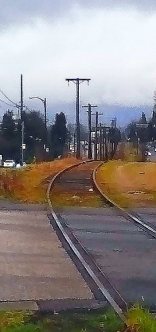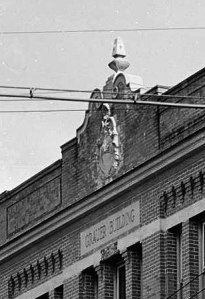Cross One At Ninth: Failure to Wait and Let Pass Caused Commuter Train Crash
 The June 12, 1907 crash on the British Columbia Electric Railway, Lulu Island Branch, that killed William McColl, occurred when a late-leaving passenger car overran written orders to wait at 9th Ave (Broadway) and crashed head-on into an in-coming work train. Both Motorman and Conductor said they forgot the orders. A Coroner’s Jury found the driver, conductor and dispatcher had all been careless and Company was equally to blame for employing inexperienced men.
The June 12, 1907 crash on the British Columbia Electric Railway, Lulu Island Branch, that killed William McColl, occurred when a late-leaving passenger car overran written orders to wait at 9th Ave (Broadway) and crashed head-on into an in-coming work train. Both Motorman and Conductor said they forgot the orders. A Coroner’s Jury found the driver, conductor and dispatcher had all been careless and Company was equally to blame for employing inexperienced men.
The collision occurred at a dip in the road at about 18 Ave and Arbutus. From 16 Avenue the driver’s view along the single track extended only as far as 23 Ave.
The construction shunter, hauling a box car and a flat-car loaded with logs, was sighted as it emerged from the “horseshoe bend” and crossed King Edward.
With both trains on downhill runs, braking was ineffective: “the two cars collided heavily in the hollow.”
There were 21 passengers on board the 5 o’clock evening commuter train, all injured more or less.
Seats were torn from the floor and passengers hurled forward 8 feet or more.
The greater weight of the construction train “telescoped” the passenger car, completely demolishing the superstructure.
 The Casualties
The Casualties
William McColl, the only confirmed fatality, was a pioneer merchant at New Westminster, son of Royal Engineer surveyor William McColl, and was now residing at Steveston where he was book-keeper at the Imperial Cannery.
An unnamed Chinese man was critically injured and not expected to live.
Jacob Grauer, “a cattle man of Eburne,”
“had his thigh broken and was otherwise injured, is suffering great pain, but it is thought he will pull through.”
J Lafond of Steveston suffered severe lacerations to his legs.
Among the “badly shaken and bruised” were William Byron, Sikitaro Oda, H. Ida, H. Kanie, W. Takasiki, James Thompson and Captain J R Tite.
The plight of the injured, if not cut and bleeding, appeared somewhat downplayed in reports. Lulu Island farmer William Gay had “suffered serious shock rendering him unconscious, but no wounds.”
Motorman BN Stevens of the passenger car “Eburne” had jumped clear and suffered only minor injuries. Conductor Edward Manning, was not hurt. Motorman George Milne, Conductor J Dumaresq, and the crew of the work vehicle were positioned far back on their car and were unharmed.
The Inquest
Proceedings of the inquest to determine the cause of death of William McColl were complicated by interested parties jockeying questions with an eye on future proceedings.
The jury heard that Dispatcher James McGuigan had handed written orders to Conductor Manning bearing the words: “Cross one at Ninth Avenue.” An order to “look out” for the work train was crossed out.
This meant that the passenger car Eburne, which was 12 minutes late in leaving Granville station downtown, was required to wait at Ninth Avenue and allow a construction train inbound from Magee, to pass by.
The Conductor of the shunter had telephoned ahead from Magee and was ordered to proceed, and would otherwise have waited there.
Questioned at the inquest, both Motorman Stevens and Conductor Manning said that on arriving at 9th Avenue they had forgotten the order to stay put.
“I forgot the order at Ninth Avenue. I remembered it at Sixth, but after that, owing to many things which took my attention, it slipped my mind.” – Stevens
The car proceeded on the single track.
Motorman BN Stevens had worked for the BCER only two months, first as a Conductor. He had been a Motorman less than two weeks. Conductor E Manning had eight years experience with the BCER.
Barring delays, the entire trip from downtown Vancouver to Steveston would take 40 to 45 minutes.
A sample of the questioning, reflecting both public speculation and the interests of the parties involved is the following.
CB Macneill, counsel for the McColl family, drew attention to the words – “Be Sure” – printed on every order paper:
“What do they mean?”
Dispatcher: “Be sure and obey orders.”
CN Woodworth, Counsel for the Crown: “Or do they mean be sure, when you disobey, to take no chances?”
This question elicited an objection from LG McPhillips, representing the BC Electric Co., and provoked a heated exchange between the lawyers.
The Coroner’s Jury, Foreman William Morden, issued the following concise and comprehensive statement:
“We find the death of Wm McColl was caused by injuries received in a collision on the Lulu Island Branch of the B.C.E.Ry. The accident we find was due to carelessness of Motorman Stevens and Conductor Manning and also to carelessness of dispatcher McGuigan in not issuing proper orders. We also find the B.C.E.Ry equally to blame in employing inexperienced men.”
- Verdict of Coroner’s Jury as recorded on death certificate for William McColl by Coroner AB Diplock, June 26, 1907.
Injured Passenger’s Son Would Run the Company
Jacob Grauer of Steveston, one of the more seriously wounded, would later sue the BCER. One of his sons, Dal Grauer, would later become a household name as head man of BC Electric.
Jacob Grauer was born in Wurtemburg, Germany in 1860. He arrived in Vancouver in 1886, setting up shop as a butcher. His first store was the City Market on Cordova Street. Integrating his business, from turf to table, Grauer raised beef cattle, sheep and dairy cows on large farms on Sea Island and at Boundary Bay.
 In 1912 Jacob Grauer erected, on River Road in Eburne Townsite, the landmark “Grauer Building.”
In 1912 Jacob Grauer erected, on River Road in Eburne Townsite, the landmark “Grauer Building.”
This block was turned into the Grand Central Hotel under the proprietorship of his son George and the Dumaresq brothers.
The building was better known later as the Marpole Infirmary, standing at the corner of Hudson Street and Marine Drive.
The Grauer Block is no longer there, but the Dal Grauer Substation, built in 1954, is still standing on Burrard Street.
